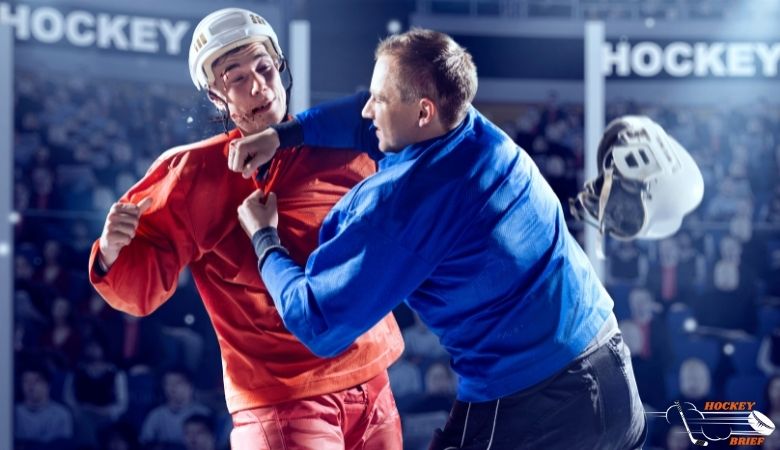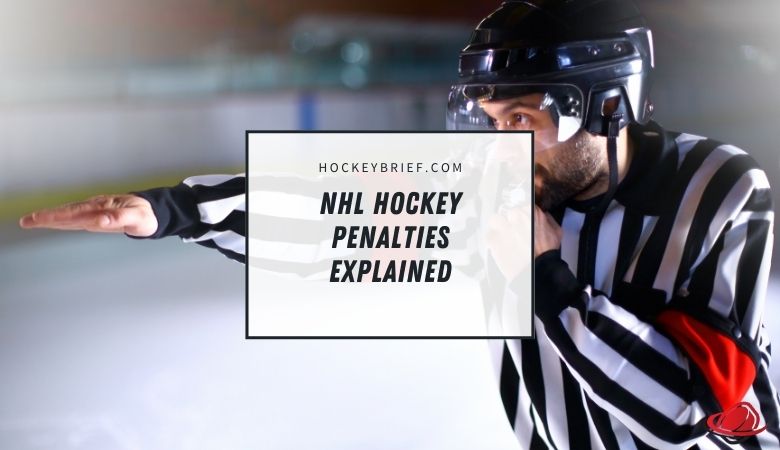There are 4 officials during an NHL hockey game that are responsible for calling any violations of the rules.
2 of the referees are in charge of calling penalties while 2 linesmen will call offsides, 2 line passes, and icing.
A penalty will be called on a player that violates any of the rules in the rulebook.
The linesman does not call a penalty but can recommend to the referee that a penalty be called on a play that perhaps was missed by the referee.
If you are curious about the types of penalties called on hockey players throughout an NHL game, this article will explain them all.

Types of NHL penalties – classification
Penalties in the NHL are broken down into 5 different classifications. They are:
- Minor penalties
- Major penalties
- Misconduct penalties
- Game misconduct penalties
- Match penalties
Minor penalty
The most common type of penalty called throughout an NHL hockey game is the minor penalty. This is where a player will receive a 2-minute penalty and must sit in the penalty box for this time unless the team on the powerplay scores a goal.
It’s possible for a player to receive a double minor penalty which is 4 minutes long. This will usually be called by the referee if the player is injured from the penalty being called.
List of minor penalties include:
- Tripping
- Boarding
- Charging
- Cross-checking
- Slashing
- Elbowing
- Roughing
- Hit to the head
- High-sticking
- Interference
- Holding
- Kneeing
- Holding the stick
- Hooking
- Unsportsmanlike conduct
- Clipping
- Spearing
Minor penalty explanations
Tripping
Using your stick, foot, knee, arm, elbow, hand causing another player to trip is called a tripping penalty.
Boarding
Making illegal contact with another player which sends them into the boards will be a boarding penalty.
Referee showing a boarding penalty signal.

Charging
Taking several strides in an attempt to accelerate and check another player is called charging.
Cross-checking
Holding the shaft of your stick with 2 hands while forcefully checking another player is a cross-checking penalty.
Slashing
Using your stick to chop or slash another player that is not an attempt to play the puck is called a slashing penalty. Slashing can involve the stick or body of another player.
Elbowing
Using your elbow to check another player is called elbowing.
Roughing
Any punching motion directed at another player will be called roughing. Also, if there is a skirmish between players a roughing penalty can be called for either one or both players.
Hit to the head
Any contact to the head of another player is a hit to the head penalty.
A double minor penalty can last 4 minutes if a player is injured.
High-sticking
If you make contact with your stick on another player above the shoulders, it will be called a high-sticking penalty.
Interference
If you make contact with another player with the intent to stop or slow them down when they don’t have the puck, an interference penalty will be called.
Holding
Using your arms to restrain another player is called holding.
Kneeing
An attempt to make contact with another player leading with your knee is a kneeing penalty.
Holding the stick
If you intentionally hold the stick of an opposing player restricting their ability to play the puck, a holding the stick penalty will be called.
Hooking
Using your stick to restrain another player is called hooking.
Unsportsmanlike conduct
If any player uses offensive, abusive, or profane language towards any other person, an unsportsmanlike conduct penalty will be called.
Clipping
Any time a player is hit at or below the knees, a clipping penalty will be called.
Spearing
Using your stick to stab or spear an opponent is called spearing.
Major penalties
A major penalty will be called by the referee if they feel that the infraction deserves a stiffer penalty. Instead of a 2-minute minor penalty, the player will be given a 5-minute major penalty.
A major penalty of 4 minutes can be called if a high sticking offense results in a player bleeding.
List of major penalties include:
- Fighting
- Checking from behind
- High sticking
- Hit to the head
- Instigating a fight
- Leaving the bench to join an altercation

Misconduct penalties
A misconduct penalty will force a player to sit in the penalty box for 10 minutes. These penalties are considered to be more serious than both minor and major penalties but don’t warrant the player being ejected from the game.
A misconduct penalty must be served for the full 10 minutes and does not result in a power play for the opposing team. The teams will remain at even strength as another player will take the place of the player in the penalty box.
Examples of a misconduct penalty include abusing an official, fighting on or off the ice, throwing items onto the ice, any other conduct that the referee deems inappropriate.
Game misconduct penalties
This penalty is similar to the misconduct penalty except the player will be ejected for the duration of the game as the misconduct is more serious.
The player will be replaced by another player and will not be allowed to return to the game. The player may also incur a fine in addition to being ejected from the game.
If the player is assessed a 5-minute major penalty on top of the game misconduct, the team will be forced to play short-handed for 5 minutes.
Match penalties
A match penalty is an automatic ejection from the game and the team is forced to play shorthanded for 5 minutes as another player must serve the time in the penalty box.
Can the goaltender commit a penalty?
Yes, the goalie can be charged with any of the same penalties as a forward or defenceman would. The difference being that the goalie does not go to the penalty box. Another player on the ice at the time of the offense must serve the time for the goalie.
If the goaltender receives a match penalty and is ejected from the game, the backup goalie will take their place and another player who was on the ice at the time will serve the duration of the penalty in the penalty box.

For more information on NHL penalties check out the official NHL rule book section 4.

